Compared to the rest of Europe Ireland has relatively few species of freshwater fish. This is primarily due to the isolation of Ireland’s rivers and lakes during the last ice age. Fish stocking and introductions (legal and illegal) have extended the range of many coarse species and now roach and bream are found all over the country. Rudd is quite widespread but tench and carp more patchy.
Of the 20 freshwater species known to inhabit this island the ISFC only recognises 11. Two hybrids are also recognized, although three are known to occur. Char, pollen and lamprey are so rarely caught (and to some degree under threat) that they are excluded and the other species are of little angling value as they are so small (e.g. minnow, gudgeon, stickleback, stone loach).
Look at the fish you can catch with us, some details on them, and the current Irish records.

Rudd (Scardinius erythrophthalmus)
Record 4.8lb taken on 5.09.1996 by Hugh Gough at Coney Lake. 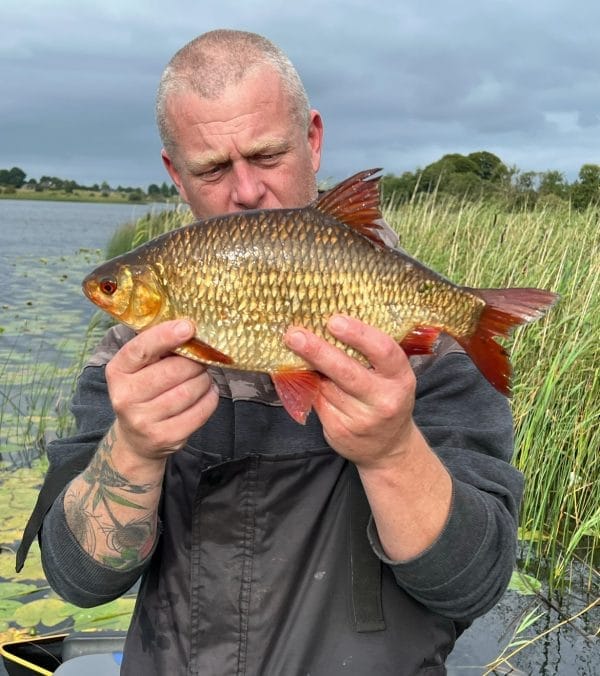
Specimen 1.98lb, or 0.9 kilo
Identification
Rudd are native throughout most of Europe, but it is not native to Ireland. Although it is an introduced species, they are considered benign as they have no significant impact on native species or ecosystems. In Ireland, they have been redistributed for angling, often to areas with smaller, isolated lakes where they have managed to escape the impact of roach: rudd thrive best in waters from which roach are absent. In Ireland, rudd can interbreed with other closely related species from the Cyprinidae family of fishes and forms hybrids with bream and, to a lesser extent, with roach.
Rudd are a beautiful golden colour, with yellow eyes, bright red pelvic and anal fins and a distinctive up-turned mouth. They prefer clean waters with plenty of aquatic vegetation and typically reside lowland lakes, still backwaters of rivers and canals, in which they form shoals that feed on invertebrates, plankton and insects, especially at the surface. They spawn in summer in shallow weedy areas.

Irish Record 1.425 Kilo taken on 6.10.2002 by Terry Jackson on Drumacritten Lake.
Specimen 2lbs or 0.907 kilo
Identification
Roach are a round-bodied fish with large dorsal fin and large tail. The anal fin has 9-12 fin rays and there are 40-46 scales along the lateral line. The under-belly is cream-white leading to iridescent silver scaled flanks and dark back. Upper fins are usually translucent brown, the pelvic and anal fins various hues of red-orange. Eyes are red.
The roach is native to most of Europe and eastwards into Asia, but it not native to Ireland. The roach is, in fact, one of our most invasive freshwater fish and has been largely blamed for the decline in some native species and other introduced species.
Roach are silver in colour with characteristically red fins, red eyes and a forwards facing mouth. They typically form shoals and feed close to the bottom in lakes, canals and deeper, slower-flowing rivers. Although relatively slow growing, roach are long-lived, and many individuals survive for more than 10 years and reach up to 2kg in weight. Roach spawn in shallow areas with dense aquatic vegetation in the late spring or early summer. In Ireland, roach can interbreed with other closely related species from the Cyprinidae family of fishes and forms hybrids with bream and, occasionally, with rudd.
Roach were first documented in Ireland in 1889 on the Munster Blackwater after their introduction as live bait, along with dace, by anglers visiting from England. By the late 1940s, they became established and even widespread in some places in the catchment. Between the 1960s and 1980s, their spread to new locations became rapid, probably as live bait and food for pike. Today, there are few, if any, major river systems that remain uncolonised by roach. Roach are one of the most important fish species for coarse anglers in Ireland today.
European eel (Anguilla anguilla)
Irish Record 6lb 15oz taken on 12.06.1979 by J.Murnane at Lough Druminesa, Bantry.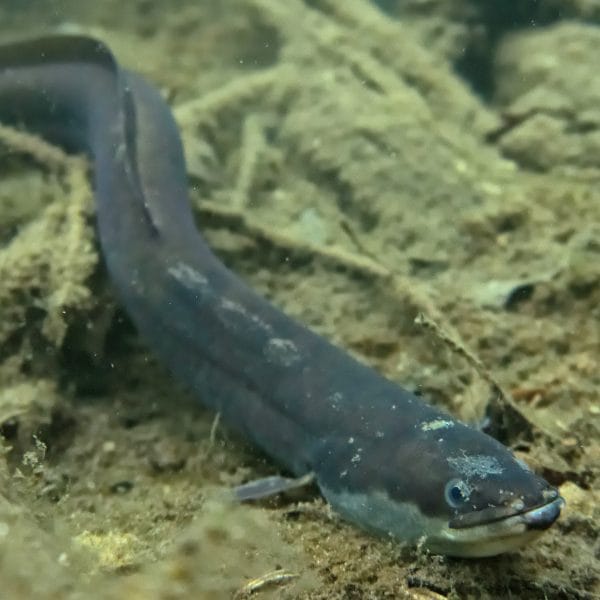
Specimen 3lb, although currently suspended from specimen list through conservation measures
Identification
The European eel is native to the North Atlantic Ocean and to the river systems of Ireland, Europe and parts of northern Africa. The European eel is a catadromous fish, which means that it hatches in the ocean but migrates to rivers to spend most of its adult life in freshwater before migrating back to the ocean to spawn. Eels are easily recognisable by their long, snake-like bodies that have no scales and their long, continuous anal and dorsal fins, with a pair of small pectoral fins just behind their heads.
European eels have a fascinating and complex life history that is still somewhat mysterious and not fully understood. European eels are believed to spawn in the Sargasso Sea, an area of Atlantic Ocean just northeast of the Caribbean; a closely related species, the American eel (Anguilla rostrata), is also believed to spawn there. After hatching, eel larvae called leptocephali drift through the ocean and metamorphose into transparent glass eels when they reach the Atlantic coasts of Europe and northern Africa. They migrate up rivers as small elvers, also called bootlace eels, to live in freshwater, where they feed on invertebrates and small fish on the bottom of rivers and lakes, growing bigger and changing colour to become yellow eels. Eels are one of Ireland’s most long-lived fish: many live to more than 25 years of age, and eels aged up to 50 years old have been recorded by the Eel Monitoring Programme.
When mature and ready to spawn, eels leave their freshwater habitat and migrate downstream while undergoing another transformation to become silver eels: their eyes get bigger, their pectoral fins lengthen and their bellies turn to a characteristic silver colour. Eels wait until the river floods during a new moon, when the night is at is darkest, before “running” downstream to reach the sea, usually between September and January. Once in the sea, the eels are believed travel along ocean currents to cover thousands of kilometres back to the Sargasso Sea to breed. Eels are believed to spawn only once and die shortly afterwards.
Sadly, the European eel is critically endangered, and the numbers of juvenile eels reaching the coast have declined dramatically in recent years. As a result, legislation now prohibits commercial fisheries and recreational angling for eels in Ireland. Possible reasons for the crash in recruitment include shifts in ocean currents due to climatic changes, mortality at barriers to migration, overfishing, habitat loss, parasites and pollution that affects fertility. One emergent threat, for example, is the eel swim-bladder worm Anguillicola crassus. This alien invasive species is a parasitic nematode that infects and damages eels’ swim bladders, thereby adversely affecting their swimming performance and ability to migrate.

Bream (Abramis brama)
Irish Record 6.07 Kilo taken on 26.06.2012 by Bryan Robinson at Ballywillan Lough, Dromore.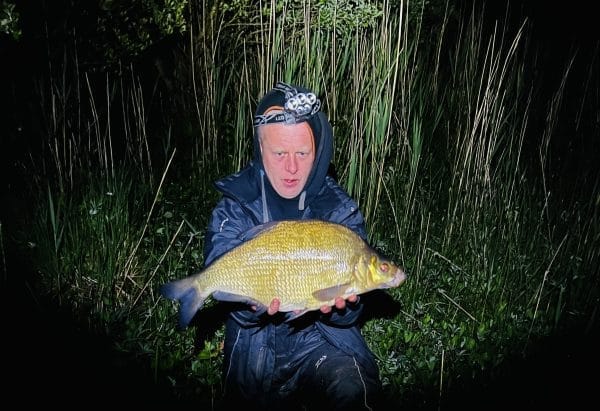
Specimen 7.5lbs or 3.402 kilo
Identification
The common bream is native to Western and Central Europe into Russia, but it is not native to Ireland. They are believed to have been introduced to Ireland during the Middle Ages to farm as food in fishponds at monastic settlements. Bream are a relatively large fish, growing to over 5kg in weight, and gather in shoals, making them an important species for coarse anglers. They may be found in lakes, canals and large slow-flowing rivers, and their distribution in Ireland is more widespread through relatively nutrient enriched waters.
Bream have black fins and deep, laterally compressed bodies that are a silvery colour in young bream, which are known as skimmers, but that turn a deep bronze colour in older fish, which are known as slabs or bronze bream. Bream are long-lived, and individuals over 20 years of age have been recorded in Ireland. Bream use their downwards facing, protruding mouth to feed on invertebrates living in shallow areas on the bottom of rivers and lakes. This bottom-feeding behaviour of bream can disturb sediment and make the water dirty or turbid, thereby having an impact on aquatic plants and other animals that live in habitat where they are present.
Bream feed most actively and spawn during the summer months when water temperatures reach about 15°C, and they frequently migrate up to 40km from their home ranges to spawning grounds. At spawning time, male bream develop small white spots called tubercles all over their heads. In Ireland, bream can interbreed with other closely related species from the Cyprinidae family of fishes and forms hybrids with roach and, occasionally, with rudd. The numbers of bream have declined where roach occur, due to competition with roach in spawning areas and proliferation of viable hybrids that now outnumber the parental bream populations.




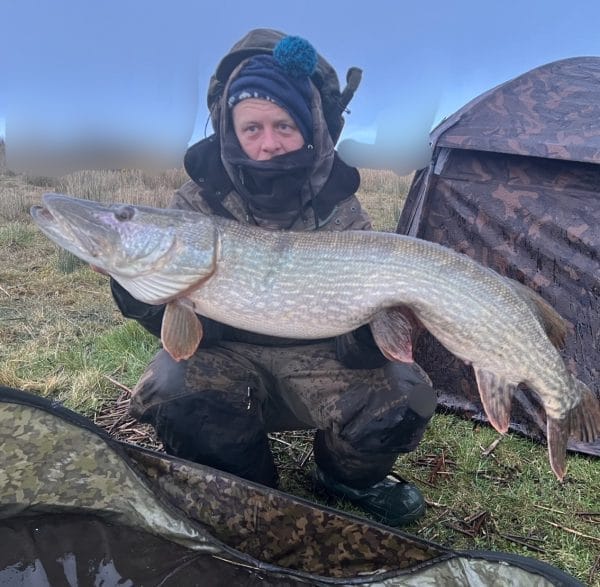 Irish Record 42lb 12oz taken on 25.09.2005 by Larry Kelly at White Lake.
Irish Record 42lb 12oz taken on 25.09.2005 by Larry Kelly at White Lake.
Specimen 30lb, or 13.608 kilo, or 115 cm fork length
River Pike (Esox lucius)
Record 42lb taken on 22.03.1964 by M.Watkins at River Barrow.
Specimen 20lb, or 9.072 kilo, or 100 cm fork length
Identification
The pike, also known as northern pike, is native throughout Europe, North America and northern Asia, where it lives in rivers and lakes, and they are also found in brackish waters along the coast of the Baltic Sea. Whether pike are native, non-native, introduced or naturalised to Ireland is a topic of highly speculative debate, and there are still considerable gaps in knowledge about Ireland’s postglacial landscape and about whether several species of freshwater fish reached river systems in Ireland by natural colonisation or human introduction, including pike. Genetic research indicates that pike populations may have reached Ireland on multiple occasions in two main waves:
- One wave appears to have reached Ireland and Britain at the same time from mainland Europe shortly after the end of the last ice age thousands of years ago and became widespread.
- Another wave around the 12th century appears to have involved introductions of pike from Britain and Europe to river catchments in the south of Ireland.
Pike are an unmistakable fish in Ireland, with a streamlined, camouflaged green body that is mottled with lighter patches along their sides, as well as a large mouth with many sharp teeth. They spawn in late spring in reeds and aquatic vegetation, and juvenile pike primarily eat benthic aquatic invertebrates and small fish. Adult pike are apex predators that feed on fish, and even occasionally small waterfowl, rodents or other pike, but even large pike will continue to also eat some invertebrates throughout their lives. Their powerful tail helps them to dart forward from ambush and seize their prey with their wide gape.
As a big, voracious predator that hits its prey hard, the pike is an exciting, hard-fighting fish to catch and is one of Ireland’s most valuable angling species for both domestic and foreign visiting anglers.

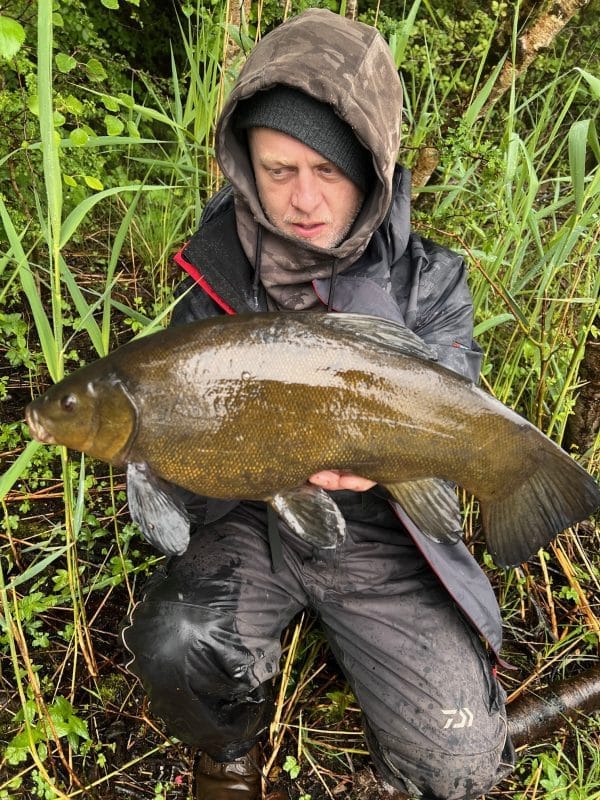 Tench(Tinca Tinca)
Tench(Tinca Tinca)
Record 8lb 15oz taken on 20.06.1995 by Nick Parry at Ballyeighter Lake.
Specimen 6lb, or 2.722 kilo, or 52 cm fork length
Identification
Tench have a rotund body shape, with large pelvic fins, a small dorsal fin and thick, muscular tail. The under-belly is light in colour and can be a variety of colours from deep yellow and orange to pale cream. The flanks are deep olive green, or sometimes green-bronze. The eyes are small and bright orange-red in colour. The scales are extremely small and the skin is smooth to touch. The pelvic fins in adult males are thick and spoon-shaped. There are two small barbules either side of the mouth.
The tench is native throughout much of Europe and northern Asia, but it is not native to Ireland. Although it is an introduced species, tench are considered benign as they have no significant impact on native species or ecosystems. They are believed to have been introduced to Ireland during the Middle Ages to farm as food in fishponds at monastic settlements, but they were frequently redistributed to angling waters, resulting in a patchy distribution around the country. They are quite a hardy fish and can tolerate both short periods out of water if kept wet and low oxygen conditions.
Tench have small red eyes and a dark green, rather stocky body that is covered with small scales and mucus. The tench is sometimes called the “doctor fish”, a name that comes from an old belief that its mucus has healing properties for other fish that rubbed against them. Males can be recognised by their curved, spoon-shaped pelvic fins on their belly, whereas those of female tench are longer and more triangular. Spawning occurs over the summer on aquatic plants in shallow areas when water temperatures are high.
Tench are a shoaling fish and inhabit lakes, canals and slow-flowing rivers, feeding on invertebrates, zooplankton, algae and molluscs on the bottom amongst aquatic vegetation. A trail of bubbles on the surface of still waters can be a sign that tench are feeding on the bottom. Coarse anglers value tench as a strong, hard-fighting fish that is associated with dense weed beds and lily pads.
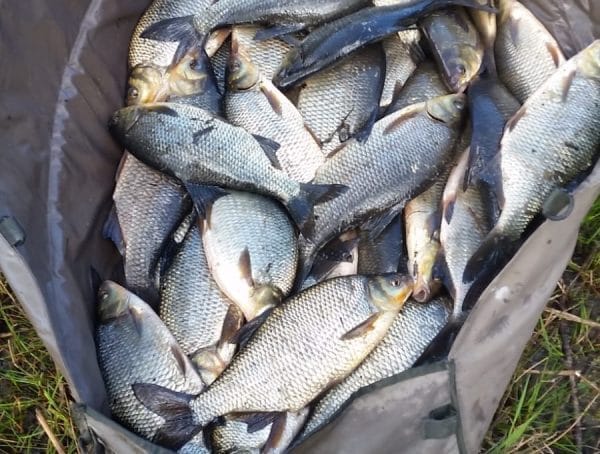
Roach/Bream Hybrid
Irish Record 3.376 kilo taken on 3.05.2013 by Jason Dingle at Monalty Lake.
Specimen 3.528lb, or 1.6 kilo
Identification
As you would expect, Roach/Bream Hybrids take on the characteristics of both parents. Normally this will result in a species that looks like a slim Bream, lighter in colour, but much more powerful, with the dogged determination of a Roach when hooked. The fins are usually dark. There are 15-20 anal ray fins and 42-54 scales along the lateral line. If you wish to claim a specimen or a record hybrid, you will need to take several scales from the fish along with clear photographs of head and fins and submit them to the Irish Specimen Fish Committee for official verification.
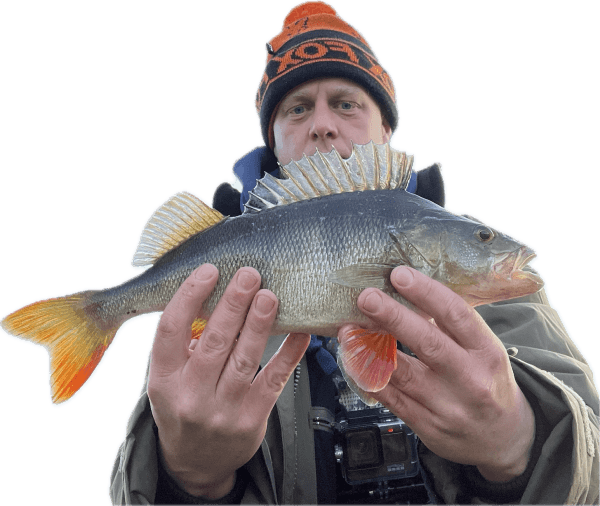 Perch (Perca fluviatilis)
Perch (Perca fluviatilis)
Irish Record 5lb 8oz taken in 1946 by S.Drum, at Lough Erne.
Specimen 2.646lbs or 1.2 kilo, or 40 cm fork length
Identification
A well-known Irish fresh water species, and quite easily identified. The obvious features are the stunning colour variations, with a cream belly leading on to bronze-green flanks and a dark green back. Vivid black stripes run vertically along the body with orange pelvic, anal and tail fins, in various hues and that iconic front dorsal fin. The spines are sharp on the front dorsal, the second dorsal is softer. The body scales are tough and the Perch has excellent eyesight and a cavernous mouth.
The perch is not native to Ireland, and it is thought to have been introduced here centuries ago to waters near monastic settlements as an easily caught, readily available source of food. The perch has since been very widely redistributed to angling waters around the country. Although their populations often undergo substantial fluctuations, perch are common and widespread fish in Ireland and are frequently caught by anglers. Indeed, the perch is the first species that many anglers catch.
Perch are widespread throughout Europe and northern Asia, inhabiting lowland lakes, ponds and slow-flowing rivers. They are also found in brackish waters along the coast of the Baltic Sea. This tolerance for a range of environmental conditions and habitats allows them to adapt to different areas where they are introduced, and they are considered to have a non-benign impact on freshwater ecosystems in Ireland because they prey upon native species or compete with them for food.
Perch are strikingly handsome fish, with a deep body, black vertical stripes over their green sides, bright red pelvic and anal fins on their bellies, a strong, spiky dorsal fin and a large mouth. Perch are a shoaling species and feed mainly at dusk and dawn on any prey unfortunate enough to encounter them, such as aquatic invertebrates, zooplankton and small fishes. They are sometimes even cannibalistic and eat their own juvenile fry. The perch’s bold and aggressive feeding behaviour will sometimes result in bursts of small fish or fry leaping from the water’s surface in a desperate attempt to escape a shoal of perch. Spawning of ribbons of eggs over aquatic vegetation takes place in late spring or early summer.
Anglers should always handle any species they catch carefully to avoid distressing or hurting fish, but this is especially true of perch. As well as a spiky dorsal fin which they can hold erect in defence, perch have sharp gill covers and spikes in their pelvic and anal fins, so they should always be handled with care to avoid injury to either perch or angler.

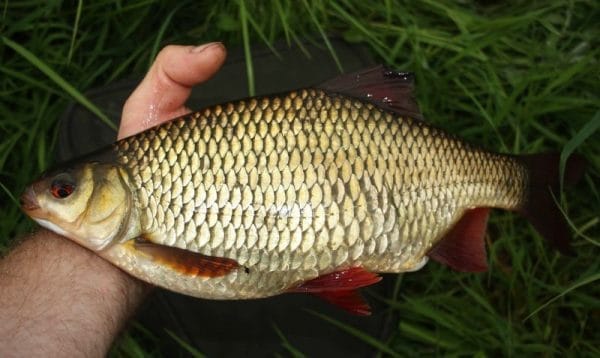
Roach/Rudd Hybrid
Irish Record 2.1 Kilo taken on 5.05.2009 by Terry Jackson at River Lagan.
Specimen 1.98lb, or 0.9 kilo
Identification
With this hybrid, the dorsal fin is large and located behind the pelvic fins. The anal fin has 9-13 branched rays and there are 39-46 scales along the lateral line. The body is “Roach-like” in appearance, with darker fins and normally a gold-bronze hue running through the upper reaches of the flanks. For accurate identification if you wish to claim a specimen or record, carefully removed 2-3 scales and submit them to The Irish Specimen Fish Committee, along with clear photographs of the head, mouth and fins.
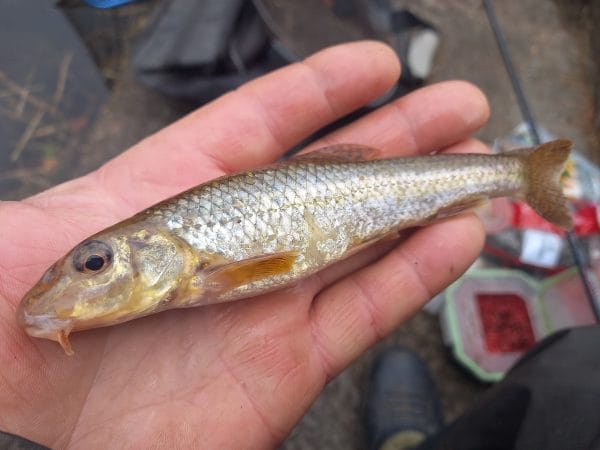 Gudgeon (Gobio gobio)
Gudgeon (Gobio gobio)
Irish Record 0.051 kilo, taken on 26.02.2022 by Terry Jackson at Portna Canal
Specimen 35grams or 1.23oz or 14 cms fork length
Identification
The gudgeon is distributed throughout most of Europe and into Russia, but it is not native to Ireland. Although it is an introduced species, gudgeon are considered benign as they have no significant impact on native species or ecosystems. They are thought to have been introduced as live bait and have a patchy distribution around Ireland, mostly in rivers and canals around the Midlands and border counties.
Gudgeon are small, rather pretty fish, with iridescent silvery purplish scales and dark streaks on their backs and tails. They often form shoals and can communicate with each other by making a squeaking sound. Gudgeon have downwards facing mouths with a pair of whisker-like barbels that they use to forage for insect larvae, crustaceans and molluscs on the bottom, especially in shallow water.
Gudgeon spawn at night in the early summer, and their eggs stick to rocks and plants until they hatch. Gudgeon typically live for three to five years and rarely exceed 20cm in length.


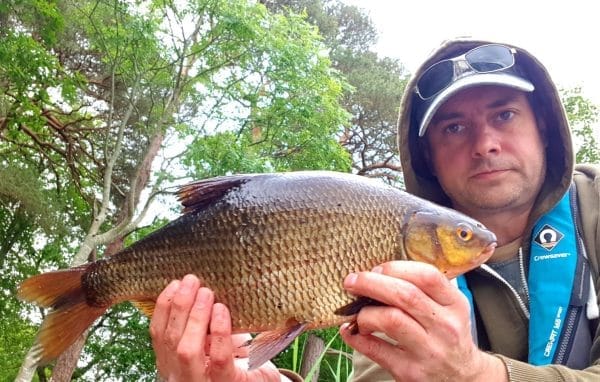
Rudd/Bream Hybrid
Record 7lb 10oz taken on 19.10.1996 by Brendan Doran at Monalty Lake.
Specimen 2.64lb, or 1.2 kilo
Identification
This hybrid when mature; is a lot smaller than an adult Bream, but stocky. It weighs quite heavy for its size when compared to other hybrids. The fins are dark, but the flanks take on a similar lustre of Rudd, in that they are a wonderful brassy-bronze colour. The anal fin has 15-21 branched rays and there are 46-50 scales along the lateral line.
